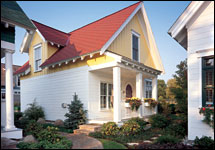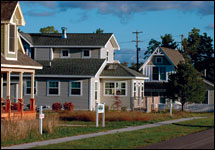Food & Farming / News & Views / Articles from 1995 to 2012 / Classic Concepts Breed Success
Classic Concepts Breed Success
Up North’s New Urbanist pioneers launched a movement
April 27, 2006 | By Keith Schneider
Great Lakes Bulletin News Service
The Bay Street Cottages feature 18 units on just 1.25 acres of land adjacent to downtown Harbor Springs.
The 55 acres of slashed dunes, deep pits, and scored earth along Lake Michigan just north of the Fifth Street beach in Manistee could have been reborn as almost anything after its life as a sand mine: An amusement park. An expanded industrial zone. A reclaimed Great Lakes natural reserve. 
Instead, starting in 1989, a group of builders under the close oversight of city officials constructed Harbor Village, a coastal vacation and retirement community that includes multi-story duplexes and, significantly, a network of tightly bound streets and 34 compact cottages designed to complement the city’s adjacent neighborhoods.
“The idea was to create a mini-neighborhood,” said Jon Rose, Manistee’s community development director. “Neo-traditional wasn’t even a buzz word back then. But they certainly captured the elements.”
Indeed, the cottages at Harbor Village, which predate the nationally prominent New Urbanist architectural movement, form the first new neighborhood in northwest Michigan constructed with traditional design principles. The cottages were the result of negotiations between the developer and the city, which wanted a buffer between the older, adjacent neighborhoods and the modern, multi-story condominiums Harbor Village’s developers wanted to build along the Lake Michigan beach. Mr. Rose recalled that, once agreement was reached, the cottages moved through the approval process with the same steady pace—at times agonizingly slow for builders—as any other development.
Since then, traditional neighborhood design principles have spread across northwestern Michigan. They’ve been used to construct similarly dense and walkable neighborhoods in Empire, Harbor Springs, Traverse City, and other places. Manistee is coming back for more, too: A proposed development in the southern sector of town, near the new high school, incorporates aspects of traditional town design, including townhouses set close to the sidewalk, separate garages, alleys, sidewalks, pocket parks, and a higher density of homes.
New Urbanism Gains Ground
 | |
| Courtesy Red Management | |
| Tim Burden's company, Red Management, is responsible for River's Edge, Midtown, and Fairway Hills, Traverse City's first three New Urbanist Developments. |
“Now that a few of these projects have been built, people are more comfortable with the idea,” said Timothy K. Burden, the president of Red Management in Traverse City, one of the premier New Urbanist developers in northwest Michigan. Mr. Burden’s company built the city’s two new neighborhoods, River’s Edge and Midtown, and is now building Fairway Hills, a 23-unit project on 17th Street.
To be sure, constructing almost any project of any size in northwest Michigan demands equal measures of vision, patience, technical expertise, and money. It’s not easy under any circumstances, say builders and local officials. Successful projects require a fortunate convergence of available land for the right price in the right location, good design, competent engineering, supportive local regulators, appropriate zoning, interested lenders, good materials, skilled craftsmen, competent managers, able marketers, and willing buyers.
So, pioneering these first smart, environmentally sensitive, energy-efficient, neighborhood-oriented, denser developments in northwest Michigan was no small order, say their builders. The many impediments included an unproven market for pedestrian-oriented neighborhoods, inflexible mortgage lending requirements, rigid building and zoning codes, and opposition from neighbors and local officials nervous about the unfamiliar.
Harbor Springs: Progress Takes Patience
For example, in 2002, when Rob Mossburg proposed replacing an old motel on a 1.25-acre site in Harbor Springs with 18 beautifully detailed units of Bay Street Cottages, set around a common landscaped walkway, the idea generated considerable talk. The city’s zoning code wouldn’t allow it, even though a large, blocky, undistinguished apartment-style building full of high-end condos could have been permitted.
But Mr. Mossburg, the owner of the Cottage Company, a four-year-old real estate development, construction, and interior design firm in Harbor Springs, patiently marketed his idea with residents and city leaders. Instead of approaching the city as an adversary, Mr. Mossburg, a member of the board of the Michigan Land Use Institute, suggested his concept during an informal planning commission hearing.
At Mr. Mossburg’s urging, the city adopted a new “cluster zoning option” in its zoning code to encourage such innovations. The developer asserted that giving builders more flexibility to construct houses clustered together would be great for homeowners, good for downtown businesses they could walk to, and would generate substantial revenue for city coffers. Indeed, when Bay Street Cottages is completed it will be valued at roughly $9 million and generate more than $150,000 a year in city, county, and school property taxes, almost 15 times more than the declining motel that used to occupy the site—an excellent yield for a 1.25 acre development. Of the 18 cottages proposed, 12 have been built and 10 sold.
That favorable experience, and his own convictions, prompted Mr. Mossburg to propose two more New Urbanist developments in Harbor Springs. One is a two-story live-work building on East Main Street, in the city’s commercial district, with space for two stores or offices on the first floor and two residences upstairs. The Harbor Springs Planning Commission approved it in 2005, and two units have been sold even before the start of construction.
The second development, Harbor Cottages, clusters nine homes between Second and Third Streets. The planning commission held a public hearing on the project on June 17, 2004; neighbors, including the city manager, who lives across the street, said they supported the idea. The planning commission applied the new cluster zoning option to the proposal and unanimously approved it the same evening.
“There is broad support for these types of projects now,” said Mr. Mossburg. “People see the quality of developments such the Bay Street Cottages and recognize the advantages of traditional neighborhood design. They realize that higher density by design creates neighborly, pedestrian-oriented land uses that are good for our northern Michigan villages.”
Empire Building
 | |
| MLUI/Gary Howe | |
| The New Neighborhood, in Empire, aims to provide neighborhood amenities at prices young families can afford. |
It took two years for Bob Sutherland, the owner of Cherry Republic in nearby Glen Arbor, and his four partners to convince the village planning commission and council to approve the project. Opponents argued it was too dense and too large. But Mr. Sutherland insisted The New Neighborhood would meet the needs of a growing community set amid Sleeping Bear Dunes National Lakeshore while conserving land, protecting the environment, and fitting the community’s character.
In the end he prevailed, in large part because of The New Neighborhood’s attention to detail and price. Lots sell for $30,000 to $56,000; a lot plus one of the 1,400- to 1,800-sq.-ft. homes goes for $160,000 to $180,000, a good buy in the northwest Michigan new housing market. The homes have three and four bedrooms, 2.5 baths, full basements, and are a five-minute walk from Empire’s business district and a 10-minute walk from the Lake Michigan beach. “We are really focused on young people who will live here year-round,” said Mr. Sutherland, also a board member of the Michigan Land Use Institute.
Traverse City Spark Plug
While Manistee was the first northern Michigan town to embrace New Urbanist design, and efforts in Harbor Springs and Empire have made the concept more mainstream, the success of northwest Michigan’s traditional developments can be traced in large part to the work of Mr. Burden and Traverse City officials, who have actively promoted neighborhood-scale design for nearly a decade. In the late 1990s, under the guidance of planner Russ Soyring, Traverse City modernized its master plan and zoning code to provide both more certainty and flexibility to developers seeking to build higher density, mixed-use developments.
The city’s new code is designed to produce more clarity for developers reluctant to try something new, protect neighbors concerned about property values and maverick building projects, and reassure bankers unaccustomed to lending for projects that fall outside of standard large-lot, single-use, sprawl-generating subdivisions.
Mr. Burden, who endured an ordeal in building River’s Edge, a mixed-use brownfield redevelopment project in the 1990s, followed the city’s guidelines to the letter in winning efficient approval for his Midtown townhouse development, now under construction along the banks of the Boardman River downtown. He appears to be on a path to similar success with Fairway Hills, now under construction on a five-acre site on a steep slope that Mr. Burden purchased for $820,000 in May 2005.
That project will eventually feature 17 handsome homes—two are under construction—designed by his company and built on 45-foot-wide lots. There also will be room for six houses on larger lots. Tying it all together is a 22-foot-wide alley with a sidewalk. The alley, a classic facet of New Urbanist design, provides access to garages and will store storm water to avoid erosion.
Fairway Hills won approval last summer by the city planning commission. “Everybody had a chance to say their piece,” said Mr. Burden. “There was so much support for the city.
“We know our way around the process by now,” he added. Then he offered his advice to other New Urbanist developers: “The formula is not hard. Do your homework. Know what you are proposing and what’s allowed. Know the zoning code. Work with the city. Keep neighbors in touch with what you are doing.”





